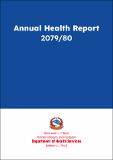Please use this identifier to cite or link to this item:
https://hdl.handle.net/20.500.14356/2682| Title: | Annual health report 2079/90 (2022-2023) |
| Authors: | Department of Health, Services |
| Citation: | Department of Health Services.(2024).Annual Health Report 2079/80. Kathmandu, Nepal; Department of Health Services, Ministry of Health and Population. |
| Issue Date: | 2024 |
| Publisher: | Government of Nepal; Ministry of Health and Population; DoHS, Ramshahpath, Kathmandu, Nepal |
| Keywords: | Health system in Nepal Department of Health Services (DoHS) Maternal and Newborn Health Services Child Health and Immunization Services Nutrition Program Family Planning and Reproductive Health Program Basic Health Services NCDs, Road-safety and Maternal Health Programs Epidemiological Surveillance, Research and Outbreak Managment Communicable Diseases, IHR and One Health National TB Control and Management Program HIV and STIs Control and Management Program Curative Services Federal Level Health Academia and Hospitals Disability and Rehabilitation One Stop Crisis Management Center and Medico-legel Services Public Health Laboratory Services Human Resoruces Capacity Building Health Education, Information and Communication Logistics and HealthInformation Management Program Human Resources in Health and Health Finance Management Department of Ayurveda and Alternative Medicine (DoAA) Department of Drug Administration (DDA) Health Insurance and Other Social Health Protection Programs Councils for Health Professionals and Health Research Health Development Partners |
| Series/Report no.: | Annual health report;2079/80 |
| Abstract: | Executive Summary: Nepal, situated in the southeast Asia region, is home to more than 29 million people. It is a federal republic nation with seven provinces and 753 local level governments (LLGs). Epidemiologically, nearly three-quarters of deaths in the country are attributed to non-communicable diseases (NCDs). Historically, until 935 BS (879 AD), health services predominantly relied on traditional medicine, particularly Ayurveda. Over time, health system has undergone different significant transformations, influenced by changes in administrative divisions and people’s movement. The evolution of Nepal’s health system, from the commitment to primary care in 1978 to Millennium Development Goals (MDGs) and now the Sustainable Development Goals (SDGs), has been supported by comprehensive health policies and robust strategies, with the most recent health sector strategy being Nepal Health Sector - Strategic Plan (NHS-SP) 2079/80- 2087/88 (2023-2030).A crucial milestone in Nepal’s journey towards universal health coverage (UHC) is the constitutional recognition of basic health as fundamental right, reinforced by legal arrangements such as the Public Health Service Act 2075 (2018) and its Regulations, 2077(2020). Responsibility for health service delivery is decentralized, with each level of government tasked with specific roles. The provision of BHS is primarily concentrated at the local level, within LLGs. The healthcare pathway begins at the grassroots level with female community health volunteers (FCHVs) and progresses through Basic Health Service Centres (BHSCs), primary, secondary, tertiary, specialized and super-specialized hospitals as the outlets of service delivery. This continuum of care is supported by health sections at LLGs, health offices, provincial health directorates (PHDs), provincial ministries overseeing the health sector, as well as departments and divisions within the Ministry of Health and Population (MoHP), ensuring effective governance of the health system. This Annual Health Report (AHR) is for fiscal year (FY) 2079/80. It serves as a comprehensive document within the health sector, fulfilling the dual purpose of monitoring progress of annual programs and providing a detailed documentation of various facets including the health scenario, guiding documents/milestones, major activities of the fiscal year (FY), program/service status and strategic analysis of the strength, weakness, opportunity, and threat for the programs and service delivery. The publication of this report is dedicated to establishing a link between service delivery and evidence-informed decision-making and planning for future programs. The report is structured into chapters covering programs across the continuum of care and the overall management of these programs. Each chapter is meticulously summarized in the subsequent sections of this report. |
| Description: | Annual Report 279-80 |
| URI: | https://hdl.handle.net/20.500.14356/2682 |
| ISBN: | 978-9-93716-148-0 |
| Appears in Collections: | MoHP Annual Report |
Files in This Item:
| File | Description | Size | Format | |
|---|---|---|---|---|
| Annual-Health-Report-2079-80.pdf | Download Full Report. | 28.6 MB | Adobe PDF |  View/Open |
Items in DSpace are protected by copyright, with all rights reserved, unless otherwise indicated.
